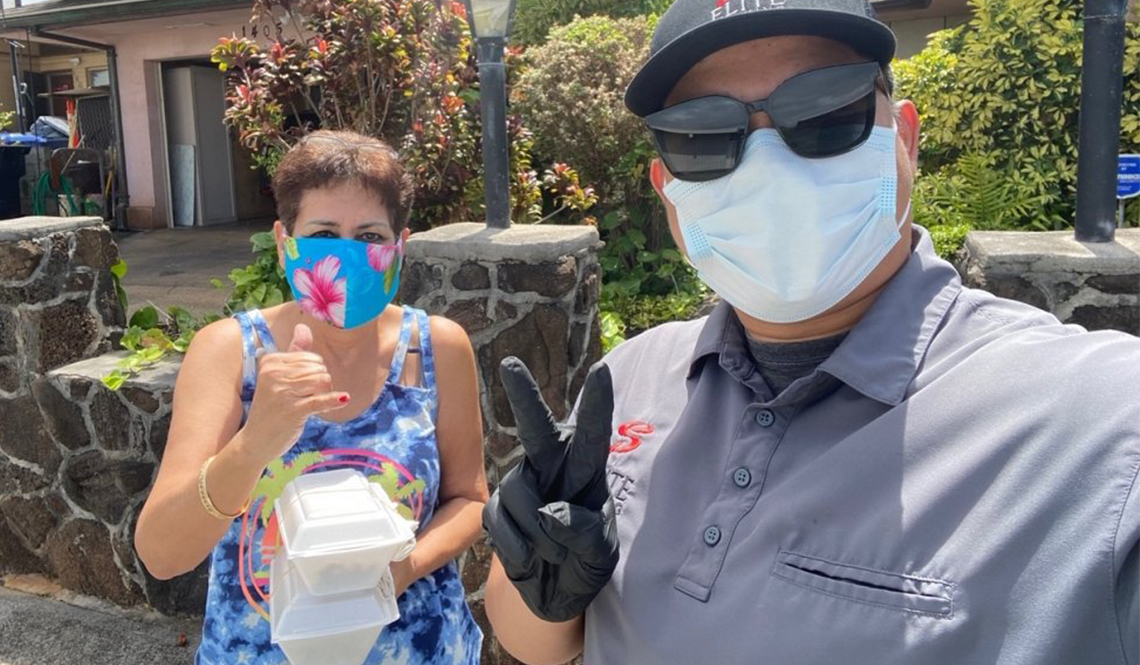Age-friendly honolulu, hawaii, and equity
Age-friendly honolulu, hawaii, and equity"
- Select a language for the TTS:
- UK English Female
- UK English Male
- US English Female
- US English Male
- Australian Female
- Australian Male
- Language selected: (auto detect) - EN
Play all audios:
THE COMMUNITY HONOLULU, HAWAII, is home to nearly 1 million residents, more than 18 percent of whom are 65 or older. The state is the nation’s most diverse, and its population is growing
older at a faster pace than the rest of the country. The city and county of Honolulu joined the AARP Network of Age-Friendly States and Communities in 2013 and completed its age-friendly
action plan in 2015. The joint initiative is called Age-Friendly Honolulu. COMMUNITY REPRESENTATIVE * Christy Nishita, Ph.D., Gerontologist, University of Hawai’i Center on Aging, and
Coordinator, Age-Friendly Honolulu PARTNER ORGANIZATIONS Preparing meals for delivery to older adults. Photo courtesy Show Aloha Challenge Additional organizations (listed here) provide food
resource and meal service assistance. EQUITY FOCUS * Food security for older adults THE WORK _CHRISTY NISHITA DESCRIBES THE WORK BEING DONE TO ENSURE FOOD ACCESS FOR LOWER-INCOME, OLDER
ADULTS._ * RESPONDING TO IMMEDIATE NEEDS "When the Honolulu age-friendly city action plan was developed in 2015, no one could have anticipated COVID-19, the stay-at-home orders and the
subsequent ways older adults would be impacted," Nishita observes. "But the plan include the need for public emergency and disaster planning to account for older adults." When
COVID-19 orders affected the city’s elders, Age-Friendly Honolulu supported the efforts of the Kupuna Food Security Coalition to ensure that the food needs of _kupuna_ [Hawaiian for older
adults] were addressed. Moving ahead, the coalition will build the community’s capacity to prepare for, withstand and recover quickly from disruptions in food supply and access, such as
natural disasters and other emergency situations. "The coalition brings together a diverse cross-sector of nearly 40 nonprofit, government, private and community organizations (see the
Partner Organizations box) to collectively address the food needs of vulnerable kupuna," says Nishita, adding that the coalition uses a data-driven approach to examine geographic areas
of need by using poverty and “working poor” definitions. From that, providers target and respond to ensure food access in those high-need areas. (The Hawaii Public Health Institute provides
resources to the coalition and facilitates data-sharing, collaboration, the exchange of best practices, volunteer recruitment and capacity-building to support the food and service
providers.) The coalition has leveraged community partnerships, raised more than $1 million in donations and foundation support, and used federal CARES Act funds to deliver food and meals
quickly and effectively to vulnerable kupuna throughout Oahu. Service provider Lanakila Meals on Wheels estimates that before the pandemic, 1 in 6 kupuna faced hunger every day. To date, the
coalition members have provided more than 1.2 million meals and served as many as 8,000 kupuna per week. * CREATING A STRONGER FUTURE Although the Kupuna Food Security Coalition was formed
to address the challenges of the COVID-19 pandemic, the group is expanding its focus to build a stronger food systems infrastructure with long-term sustainable strategies and solutions.
"We want to build broad, diverse and innovative community partnerships to ensure that our vulnerable kupuna — those in poverty, or struggling to make ends meet, or living alone with no
family support, or with limited mobility — have equitable access to nutritious meals, food and wraparound services, enabling them to age-in-place," says Nishita. She adds: "The
coalition exemplifies the opportunity for communities to build and harness cross-sector partnerships that address critical community issues with focused intention to support its most
vulnerable residents.” RELATED RESOURCES AARP LINKS Visit another community: Age-Friendly Network Communities and Equity _Reported by Mary Kay Bailey | Fall 2020 | _Population data from
the U.S. Census More from AARP.org/Livable Use the dropdown to choose a livability topic. Select a Subject
Trending News
Brazil exploring legal routes to ban huawei's 5g network - reportAugusto Heleno, Bolsonaro's national security adviser, and Brazil's ministry of communications are examining t...
Alarm as insurer reports spike in diabetes casesCathy O'Leary Medical EditorThe West Australian Health insurer HBF has had an alarming surge in claims from people ...
Cracking jokes: four rules for humourAlan Roberts is the author of The Philosophy of Humour, published by Palgrave in Spring 2019. (https://www.palgrave.com/...
Homemade tiffin service resumes with bio-degradable packagingTiffin Aaw, the tiffin service, has introduced environmental friendly packing of biodegradable material made of sugarcan...
Hematological defects in the oc/oc mouse, a model of infantile malignant osteopetrosisABSTRACT Infantile malignant osteopetrosis (IMO) is a rare and lethal disease characterized by an absence of bone resorp...
Latests News
Age-friendly honolulu, hawaii, and equityTHE COMMUNITY HONOLULU, HAWAII, is home to nearly 1 million residents, more than 18 percent of whom are 65 or older. The...
For the record - sept. 1, 2017Sept. 1, 2017 12 AM PT DOLE CUTBACKS: In the Aug. 30 Business section, an article about Dole Food Co.’s plans to reduce ...
Japan’s growing anti-korea sentimentAccording to a recent survey, almost 70 percent of Japanese people do not have friendly feelings towards Korea, suggesti...
Met dept forecasts heavy rainfall in rajasthanThe meteorological department has forecast heavy rains in most parts of Rajasthan for the next five days. It has issued ...
Effect of census on state assembly seatsBased on 1990 Census figures, Los Angeles County is likely to lose as many as two seats in the 80-member Assembly as par...
